Complete Solutions to Physics of chapter TS EAMCET 2018 (4 MAY SHIFT 1) of Class 12 book with complete answers and questions
| Class 12 | PHYSICS |
| Chapter | TS EAMCET 2018 (4 MAY SHIFT 1) |
| TS EAMCET | Physics |
| Number Of Questions | 40 |
| Academic Year | 2023-24 |
Assertion (A) When we bounce a ball on the ground, it comes to rest after a few bounces, losing all its energy. This is an example of violation of conservation of energy.
Reason (R) Energy can change from one form to another but the total energy is always conserved.
Which of the following is true?
View SolutionA gas satisfies the relation `pV^(5//3) = k`, where p is pressure, V is volume and k is constant. The dimension of constant k are
View SolutionA car moves in positive y-direction with velocity v proportional to distance travelled y as `v(y) prop y^(beta)`, where `beta` is a positive constant. The car covers a distance L with average velocity `lt v gt` proportional to L as `lt v gt prop L^(1//3)`, The constant `beta` is given as
View SolutionConsider a particle moving along the positive direction of X-axis. The velocity of the particle is given by `v = alphasqrt(x)` (`alpha` is a positive constant). At time t = 0, if the particle is located at x = 0, the time dependence of the velocity and the acceleration of the particle are respectively
View SolutionThe magnitude of velocity and acceleration and velocity of a particle moving in a plane, whose position vector `r = 3t^(2)hati+2thatj+hatk` at t = 2s are respectively
Note In the question paper sequence is given, (acceleration and velocity) which is not matching with any of option given.
View SolutionTwo objects are located at height 10 m above the ground. At some point of time, the objects are thrown with initial velocity `2sqrt(2)` m/s at an angle `45^(@)` and `135^(@)` with the positive X-axis, respectively. Assuming `g = 10 m/s^(2)`, the velocity vectors will be perpendicular to each other at time is equal to
View SolutionString AB of unstretched length, L is stretched by applying a force F at the mid-point C such that the segments AC and BC make an angle `theta` with AB as shown in the figure. The string may be considered as an elastic element with a force to elongation ratio K. The force F is given by
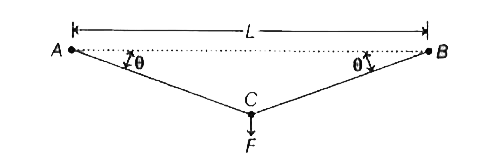
View SolutionA block of mass 5 kg is kept against an accelerating wedge with a wedge angle of `45^(@)` to the horizontal. The coefficient of friction between the block and the wedge is `mu = 0.4`. What is the minimum absolute value of the acceleration of the wedge to keep the block steady? [Assume, `g = 10 m/s^(2)`]

View SolutionAn object moves along the circle with normal acceleration proportional to `t^(alpha)`, where t is the time and `alpha` is a positive constant. The power developed by all the forces acting on the object will have time dependence proportional to
View SolutionA ball of mass 1 kg moving along x-direction collides elastically with a stationary ball of mass m. The first ball (mass = 1 kg) recoils at right angle to its original direction of motion. If the second ball starts moving at an angle `30^(@)` with the X-axis, then the value of m must be
View SolutionA machine gun can fire 200 bullets/min. If 35 g bullets are fired at a speed of 750 m/s, then the average force exerted by the gun on the bullets is
View SolutionA solid sphere of radius R makes a perfect rolling down on a plane which is inclined to the horizontal axis at an angle `theta`. If the radius of gyration is k, then its acceleration is
View SolutionA particle of mass m is attached to four springs with spring constant k, k, 2k and 2k. as shown in the figure. Four springs are attached to the four corners of a square and a particle is placed at the center. If the particle is pushed slightly towards any sides of the square and released, the period of oscillation will be

View SolutionThe ratio of the height above the surface of earth to the depth below, the surface of earth, for gravitational accelerations to be the same (assuming small heights) is
View SolutionA steel rod has radius 50 mm and length 2 m. It is stretched along its length with a force of 400 KN. This causes an elongation of 0.5 mm. Find the (approximate) Young's modulus of steel from this information.
View SolutionConsider a vessel filled with a liquid upto height H. The bottom of the vessel lies in the XY-plane passing through the origin. The density of the liquid varies with Z-axis as `rho(z)=rho_(0)[2-((z)/(H))^(2)]`. If `p_(1)` and `p_(2)` are the pressures at the bottom surface and top surface of the liquid, the magnitude of `(p_(1)-p_(2))` is
View SolutionA one mole of ideal gas goes through a process in which pressure p varies with volume V as `p =3-g((V)/(V_(0)))^(2)`, where, `V_(0)` is a constant. The maximum attainable temperature by the ideal gas during this process is
(all quantities are is SI units and Ris gas constant)
View SolutionThe internal energy of the air, in a room of volume V, at temperature T and with outside pressure p increasing linearly with time, varies as
View SolutionThe efficiency of Carnot engine is y, when it `eta` hot and cold reservoirs are maintained at temperature `T_(1)` and `T_(2)`, respectively. To increase the efficiency to `1.5 eta`, the increase in temperature `(DeltaT)` of the hot reservoir by keeping the cold one constant at `T_(2)` is
View SolutionAn air bubble rises from the bottom of a water tank of height 5 m. If the initial volume of the bubble is `3" mm"^(3)`, then what will be its volume as it reaches the surface? Assume that its temperature does not change.
`[g=9.8m//s^(2),1" atm "=10^(5)” Pa, density of water"=1" gm"//"cc"]`
View SolutionTwo harmonic travelling waves are described by the equations `y_(1)=a sin(kx-omega t)` and `y_(2)=a sin(-kx+omega t+phi)`. The amplitude of the superimposed wave is
View SolutionWhere should an object be placed on the axis of a convex lens of focal length 8 cm, so as to achieve magnification of -4? (Distances are measured from optic centre of the lens)
View SolutionA converging mirror is placed on the right hand side of a converging lens as shown in the figure. The focal length of the mirror and the lens are 20 cm and 15 cm, respectively. The separation between the lens and the mirror is 40 cm and their principal axis coincide. A point source is placed on the principal axis at a distance d to the left of the lens. If the final beam comes out parallel to the principal axis, then the value of d is
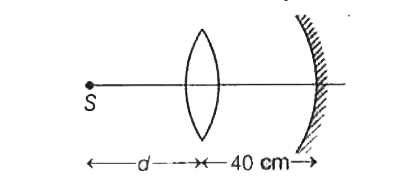
View SolutionInterference fringes are obtained in a Young's double slit experiment using beam of light consisting two wavelengths 500 nm and 600 nm. Bright fringes due to both wavelengths coincide at 2.5 mm from the central maximum. If the separation between the slits is 3 mm, then the distance between the screen and plane of the slits is
View SolutionA point charge of 50 uC is placed in the XY-plane at a location with radius vector `r_(0)=2hati+3hatj` m. The electric field strength and its magnitude at a point with radius vector `r=8hati-5hatj` m is
`(epsilon_(0)=8.85xx10^(-12)C^(2)//N-m^(2))`
View SolutionThe work done to assemble the three charges in a configuration as shown in the figure below is
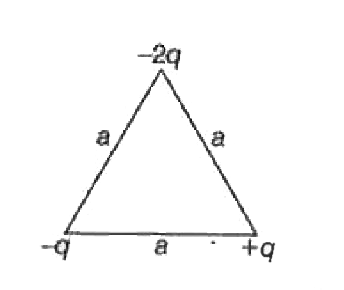
View SolutionConsider the following two circuits
[A] 20 bulbs are connected in series to a power supply line.
[B] 20 bulbs identical to [A] are connected in a parallel circuit to an identical power supply line.
Identify which of the following is not true?
View SolutionA tapered bar of length L and end diameters `D_(1)` and `D_(2)` is made of a material of electrical resistivity `rho`. The electrical resistance of the bar is
View SolutionTwo circular loops `L_(1)` and `L_(2)` of wire carrying equal and opposite currents are placed parallel to each other with a common axis. The radius of loop `L_(1)` is `R_(1)` and that of `L_(2)` is `R_(2)`. The distance between the centres of the loops is `sqrt(3)R_(1)`. The magnetic field at the centre of `L_(2)` shall be zero, if
View SolutionA non-conducting thin disc of radius R rotates about its axis with an angular velocity `omega`. The surface charge density on the disc varies with the distance r from the centre as `sigma(r)=sigma_(0)[1+((r)/(R))^(beta)]`, where `sigma_(0)` and `beta` are constants. If the magnetic induction at the center is `B=((9)/(10))mu_(0)sigma_(0)omegaR`, the value of `beta` is
View SolutionA bar magnet of magnetic moment Mis placed at a distance D with its axis along positive X-axis. Likewise, second bar manget of magnetic moment M is placed at a distance 2D on positive Y-axis and perpendicular to it as shown in the figure. The magnitude of magnetic field at the origin is `|B|=alpha[(eta_(0))/(4pi)(M)/(D^(3))]`. The value of a must be (assume `D gt gt l`, where l is the length of magnets)
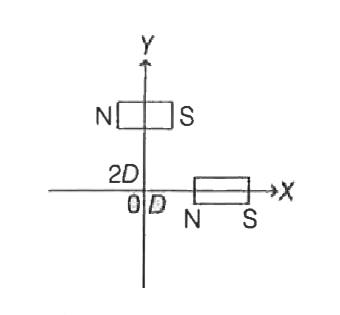
View SolutionA wire loop enclosing a semi-circle of radius Ris located on the boundary of a uniform magnetic field of induction B. At timc t = 0, the loop is set into rotation with angular velocity angular `omega` about its axis 0, coinciding with a line vector B on the boundary as shown in the figure. The emf induced in the loop is
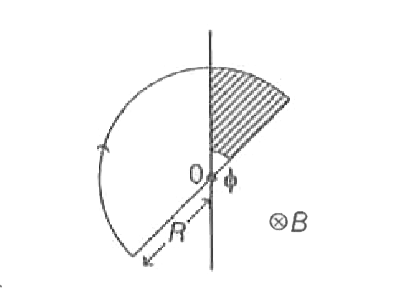
View SolutionIn the circuit given below, the capacitor C is charged by closing the switch `S_(1)` and opening the switch `S_(2)`. After charging, the switch `S_(1)` is opened and `S_(2)`, is closed, then the maximum current in the circuit
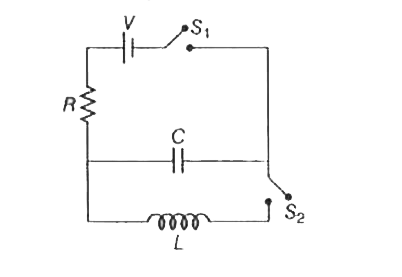
View SolutionA 100 W electric bulb produces electromagnetic radiation with electric field amplitude of `(2V)/(m)` at a distance of 10 m.
Assuming it as a point source, estimate the efficiency of the bulb.
View SolutionAt an incident radiation frequency of `v_(1)`, which is greater than the threshold frequency, the stopping potential for a certain metal is `V_(1)`. At frequency `2v_(1)`, the stopping potential is `3V_(1)`. If the stopping potential at frequency `4v_(1)` is `nV_(1)` then n is
View SolutionThe de-Broglie wavelength of an electron of kinetic energy 9 eV is (take, `h=4xx10^(-15)eV-s,c=3xx10^(10)cm//s` and the mass `m_(e)` of electron as `m_(e)c^(2)=0.5` MeV
View SolutionAn active nucleus decays to `((1)/(3))` rd in 20 h.
The fraction of original activity remaining after 80 h is
View SolutionConsider an amplifier circuit, where in a transistor is used in common emitter mode. The change in collector current and base current respectively are 4 mA and 20 UA when a signal of 40 mV is added to the base-emitter voltage. If the load resistance is 10 k 2, then power gain in the circuit is
View SolutionThe output F of the logic circuit given below is

View SolutionA carrier wave of peak voltage 20 V is used to transmit a message signal. For getting a modulation index of `60%`, the peak voltage of the modulating signal is
View Solution
Physics questions and complete solutions for chapter TS EAMCET 2018 (4 MAY SHIFT 1) of TS EAMCET PREVIOUS YEAR PAPERS of Class 12